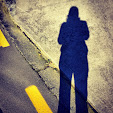 |
| The Beast in acrylic |
So here comes a complete run down of how I go to this stage:
When I realised the week before last that I would not be able to use the latticework method of construction described
here for my 3d object, I went back to the idea of sections and decided the best way would be to section off the two objects that make up the beast separately. There's a way to slice each of them so that you get the optimal amount of detail in each section. So I sliced the black object like this:
 |
| Screen grab 3ds Max Black object |
And the red one like this:
 |
| Screen grab 3ds Max Red Object |
I turned these sections into shapes in 3ds Max and then placed them all on the same plane and exported them into Illustrator. This didn't work too well and in the end I just saved each shape (which become the cutting paths) individually into Illustrator. I had been shown a way to explode them in AutoCAD which might help simplify the multiple faces that 3ds Max generates but it all got a bit complicated when I realised I needed to learn to use AutoCAD too...
Here's the AutoCAD file of the red object:
So I arrived at the file I handed in last Tuesday (
here)
We got our acrylic and card files back on Thursday. I brought them home and immediately started to construct the Beast using glue - mainly for the purpose of seeing how it would look when complete as well as to use as a guide for when I sew it together.
I made the red shape first. I have cute two squares on the part where the two long pieces join so that you can see the exact angle they must lie on when being joined together. Here's how it went:
 |
| Using fine red thread to start with... |
 |
| ...and then broke it while unpicking the first sewing attempt |
 |
| Second attempt with card...Good old bull-clips - the king of assembly tools |
 |
| That worked |
 |
| Then I added the acrylic and began the wrap. |
From there I focused entirely on the acrylic version. I used the numbers and the 3ds Max and Illustrator files to guide me on placing the pieces.
 |
| Using my numbers to assemble sections of the beast |
 |
| Slowly the sections came together |
 |
| Another angle shows better how the red object will look when they are finished and in place |
I have been able to sew together the pieces in a preliminary test so the absence of glue doesn't seem to present any major problems. I am using embroidery thread to wrap the beast which I should have put together by Tuesday night so that I can spend Wednesday photographing the final product.
...slight glitch - two of my shapes have not been cut (all the way through) in the card so I am hoping I can either get them cut tomorrow or (if worst comes to worst) cut them myself. As you can see below, you can see the line they are supposed to be cut on...
 |
| Card |






























































